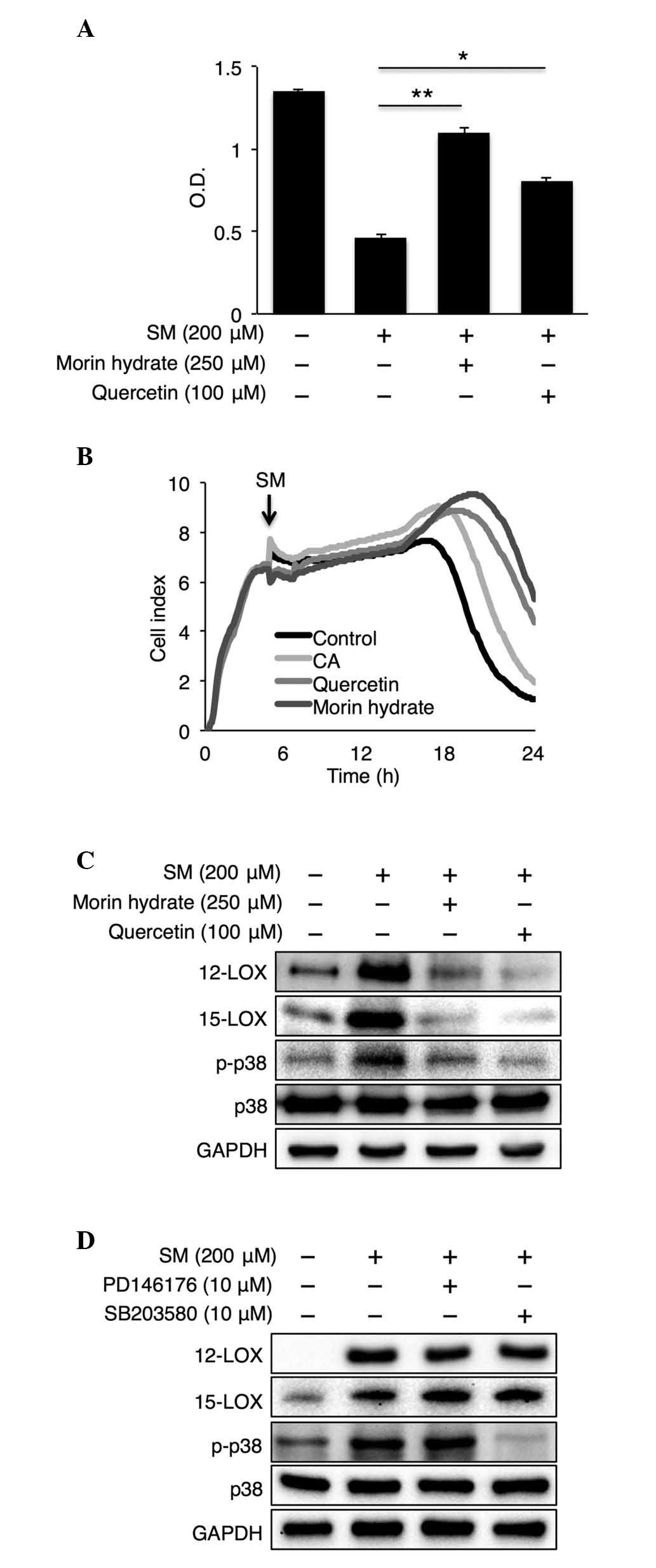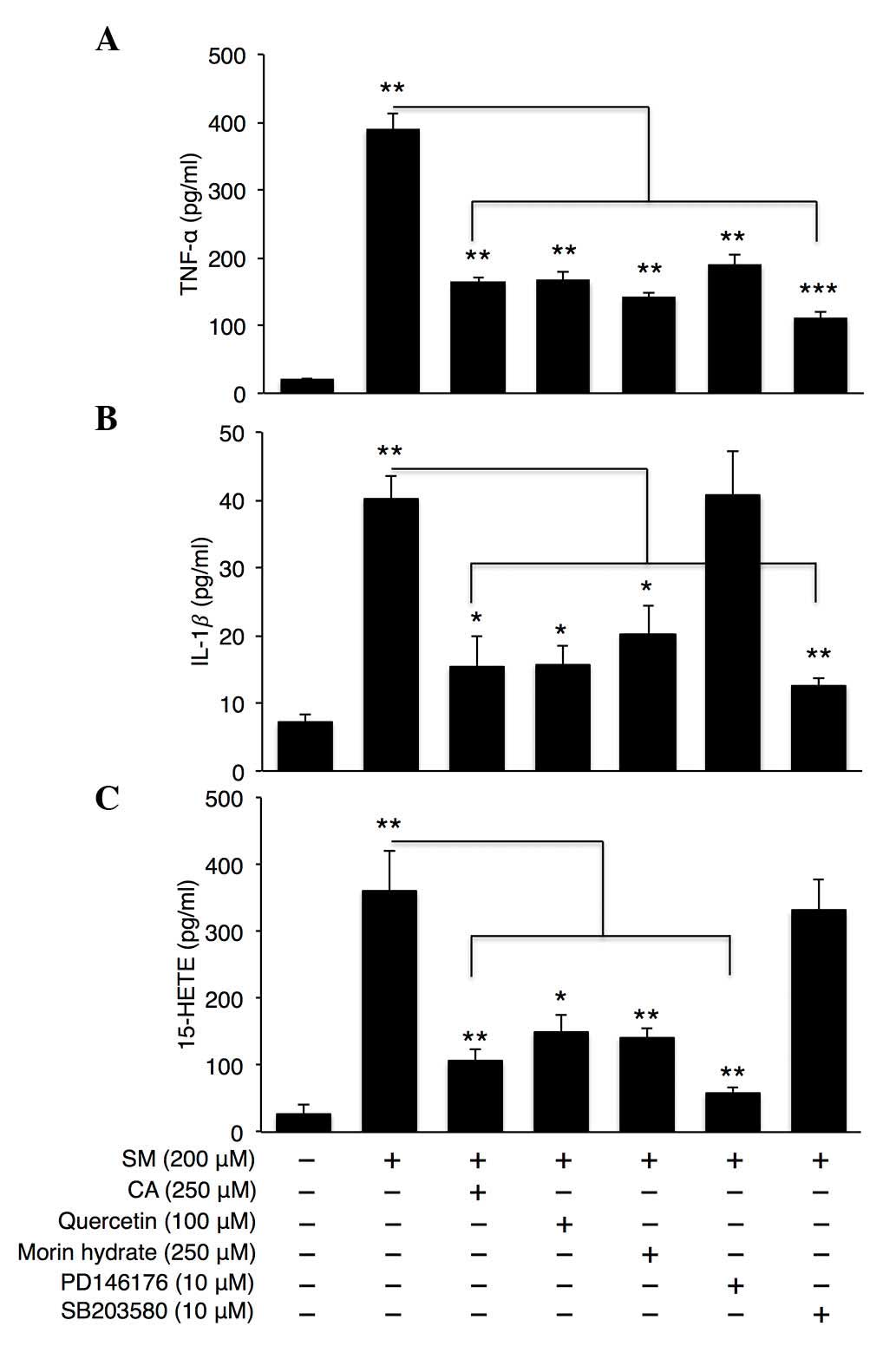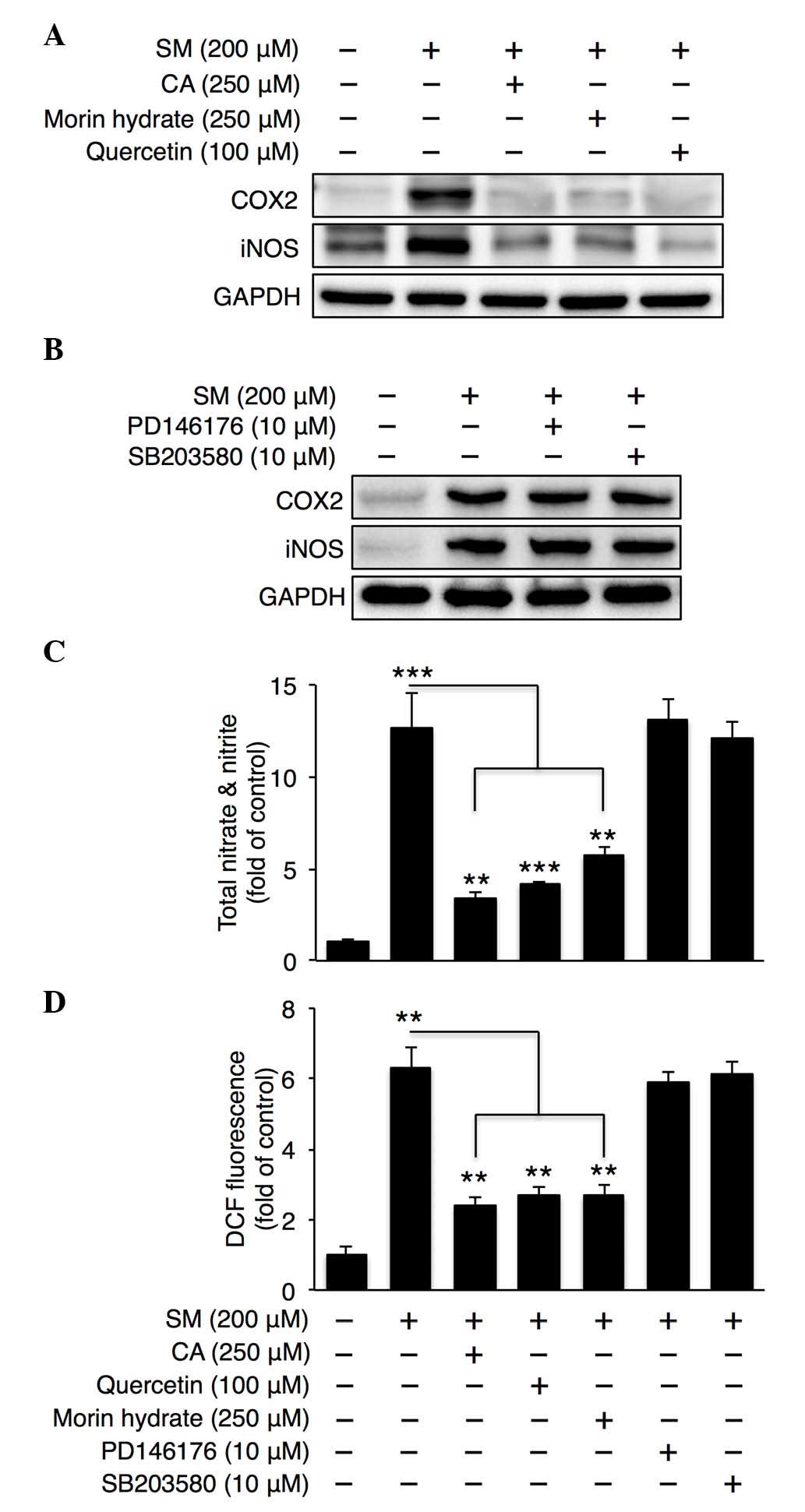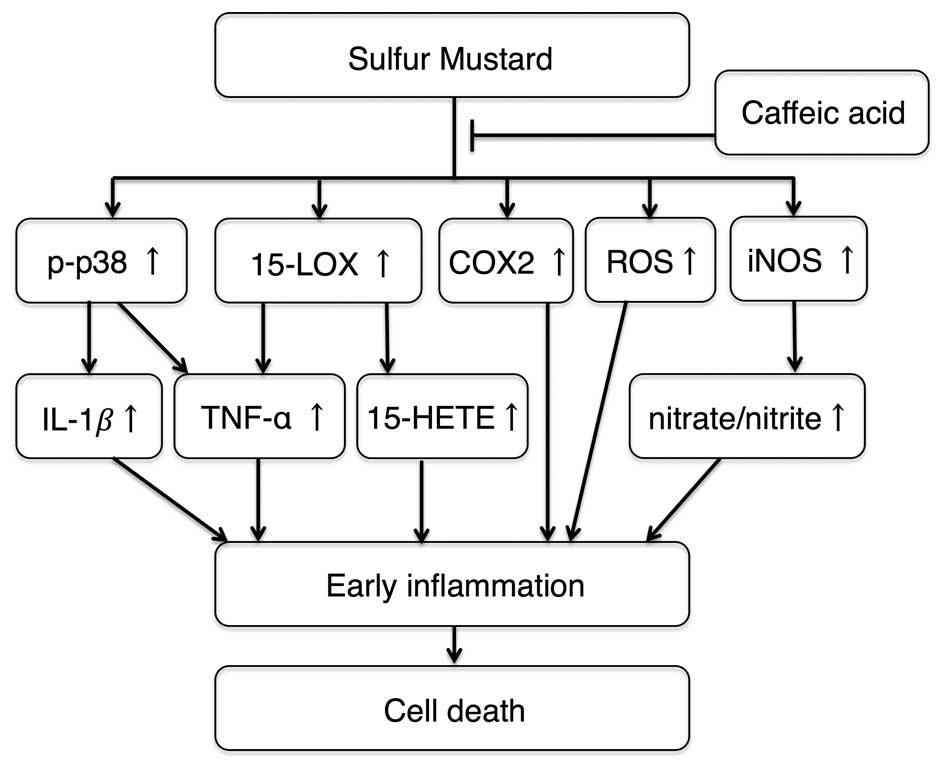Caffeic acid, morin hydrate and quercetin partially attenuate sulfur mustard-induced cell death by inhibiting the lipoxygenase pathway
- Authors:
- Published online on: September 23, 2016 https://doi.org/10.3892/mmr.2016.5766
- Pages: 4454-4460
Abstract
Introduction
Sulfur mustard (SM; 2,2′-dichlorodiethyl sulfide), commonly known as mustard gas, is a potent bifunctional alkylating agent (1), and was used as a chemical weapon during World War I (1914–1918). Although more toxic chemical warfare agents are currently available, mustard gas has remained the chemical weapon of choice in modern warfare, as evidenced by its use during the Iran-Iraq war between 1980 and 1988 (2). SM is a reactive chemical causing skin, ocular and pulmonary damage (1). Among these, the primary target organ of SM is the skin, which exhibits erythema, hyperpigmentation, inflammation, blistering and severe necrosis (1). As no effective treatment for the vesicant-inducing properties of SM has been established (3), the development of novel therapeutic agents for SM-induced toxic symptoms is clinically urgent considering the possibility of its use during future conflict.
Various molecules have been suggested to be involved in the mechanism of SM-induced toxicity. Firstly, SM causes DNA damage, which activates the poly (ADP-ribose) polymerase (PARP) nuclear protein (1,4). The increased activation of PARP depletes NAD+ and intracellular ATP levels, leading to necrotic cell death. SM-induced DNA damage can also be caused by its DNA adducts, which are formed predominantly at the N7-position of guanine and the N1-/N3-position of adenine (1). These DNA adducts eventually cause cell cycle arrest, leading to cell death. Secondly, SM induces apoptotic cell death by increasing the expression levels of Fas receptor, Fas ligands, tumor necrosis factor (TNF) receptor ligands and TNF-α. SM also activates caspase-8 and its downstream caspases, including caspase-3, −6 and −7 (1). Thirdly, endoplasmic reticulum stress with changes in calcium homeostasis has also been reported to be induced by SM through the modulation of calcium-calmodulin signaling (1,5). SM can also alter signaling pathways, including p38 mitogen-ativated protein (MAP) kinase and matrix metalloproteases (MMPs). The SM-induced activation of p38 MAP kinase is involved in cytokine release (6) and MMPs are important in SM-induced skin blistering (1). Furthermore, SM activates nuclear factor (NF)-κB signaling (7), and increases the generation of reactive oxygen species (ROS) and nitric oxide, which depletes glutathione (8). Therefore, antioxidants have been used as therapeutic agents for SM-induced toxicity (9–11). However, the therapeutic efficacy of antioxidants is not clinically satisfactory and current treatments are only supportive.
Historically, therapeutic agents were predominantly obtained from various plants, and natural selection and competition among species led to the synthesis of secondary metabolites with marked biological activities (12). Caffeic acid (CA), an active component of propolis, which has anti-inflammatory and anticarcinogenic properties (13), and inhibits 15-lipoxygenase (LOX) (14). Several other natural 15-LOX inhibitors, including quercetin (15), a flavonoid found in a number of vegetables and fruits, and morin hydrate, a yellow substance found in oranges and guava (16), have been reported previously.
LOX is an enzyme catalyzing the deoxygenation of polyunsaturated fatty acids in lipids containing a cis, cis-1,4-pentadiene structure, which generates the fatty acid, hydroperoxide (17). LOX reactions can modulate signaling pathways via the generation of leukotrienes or 12-hydroxyeicosatetraenoic acid (12-HETE), but can also induce structural or metabolic alterations inside the cell (17). In the present study, it was demonstrated that CA, quercetin and morin hydrate not only reduced SM-induced inflammatory cytokines via 15-LOX inhibition, but also reduced SM-induced oxidative stress and the generation of nitrate/nitrite.
Materials and methods
Materials
CA, tannic acid (TA), deferoxamine mesylate, trolox, vitamin C, ellagic acid, N-acetyl-L-cysteine, quercetin, morin hydrate, SB203580, PD146176 and 2′,7′-dichlorofluorescein diacetate (DCF-DA) were purchased from Sigma-Aldrich; Thermo Fisher Scientific, Inc. (Waltham, MA, USA). Antibodies detecting Thr183/Thr185-phosphorylated-c-jun N-terminal kinases (JNKs; cat. no. 9255), JNKs (cat. no. 9252), Thr180/Tyr182-phosphorylated-p38 (cat. no. 4511), p38, Ser15-phosphorylated-p53 (cat. no. 9284), p53 (cat. no. 2524) and cyclooxygenase 2 (COX2; cat. no. 12282), all purchased from Cell Signaling Biotechnology (Beverly, MA, USA), and inducible nitric oxide synthase (iNOS; cat. no. ab3523; Abcam, Cambridge, MA, USA). 12-LOX (cat. no. sc-32939) and 15-LOX (cat. no. sc-67143) antibodies were obtained from Santa Cruz Biotechnology, Inc. (Santa Cruz, CA, USA). Glyceraldehyde-3-phosphate dehydrogenase (GAPDH; cat. no. MAB374) antibody was purchased from EMD Millipore (Billerica, MA, USA). Anti-mouse-horseradish peroxidase (HRP; cat. no. 115-036-003) and anti-rabbit-HRP (cat. no. 111-035-003) antibodies were purchased from Jackson Laboratory (Bar Harbor, ME, USA). The SM was provided from the Agency for Defense Development (Daejeon, Korea).
Cell culture
Normal human epithelial keratinocytes (NHEKs) were purchased from ZenBio, Inc. (Research Triangle Park, NC, USA). The NHEKs were grown in KM-3 growth medium (ZenBio, Inc.) in 5% CO2 at 37°C. All experiments were performed with NHEKs at passages 3–5.
Measurements of TNF-α, interleukin-1β (IL-1β) and 15-hydroxyeicosatetraenoic acid (15-HETE)
The NHEKs at 80% confluence were treated with 200 µM of SM with or without antioxidants. After 18 h, the levels of TNF-α, IL-1β and 15-HETE in the culture medium were measured using TNF-α and IL-1β Human ELISA kits (AbFrontier, Seoul, Korea) and a 15-HETE ELISA kit (Abcam, Cambridge, MA, USA) according to the manufacturer's protocols.
Western blot analysis
The NHEKs were lysed using RIPA buffer containing 50 mM Tris-Cl (pH 7.5), 150 mM NaCl, 1% Nonidet P-40, 0.5% sodium deoxycholate, 0.1% SDS, protease inhibitors and phosphatase inhibitors (Sigma-Aldrich; Thermo Fisher Scientific, Inc.) and protein levels were examined using Protein Assay Dye reagent (Bio-Rad Laboratories, Inc., Hercules, CA, USA). The proteins (50 µg) were separated by SDS-PAGE on 8–15% SDS polyacrylamide gels and transferred onto PVDF membranes (Bio-Rad Laboratories, Inc.). The membranes were blocked with the 5% skim milk for 1 h and incubated with primary antibodies overnight at 4°C. The membranes were then incubated with secondary antibodies for 1 h at room temperature. The protein bands were detected on X-ray film using ECL Western Blotting Detection reagents (GE Healthcare Life Sciences, Little Chalfont, UK).
3-(4,5-dimethylthiazol-2-yl)-2,5-diphenyltetrazolium bromide (MTT) cell viability assay
Cell viability was determined using an MTT assay. Briefly, 5×104 NHEKs were grown overnight in 96-well plates, and were treated with 0–800 µM SM for 24 h with or without antioxidants (10 µM TA, 250 µM DFM, 250 µM Trolox, 100 mM vitamin C, 250 µM EA, 250 µM CA and 10 mM NAC). Following treatment, MTT solution was added (0.5 mg/ml final concentration), and incubated for 4 h at 37°C with 5% CO2. The supernatant was discarded and 200 µl dimethyl sulfoxide was added. The production of solubilized purple formazan crystals was quantified by exposure to a wavelength of 540 nm.
Real-time cell electronic sensing (RT-CES)
The NHEKs (5×104) were incubated in 16 plastic wells with 16X microelectronic sensor devices. At 5 h post-cell attachment, 200 µM SM with or without 250 µM CA, 100 µM quercetin or 250 µM morin hydrate, was added. Data was collected every 3 min using an RT-CES system (ACEA Biosciences, San Diego, CA, USA).
ROS measurement and nitrate/nitrite assay
The NHEKs treated with 200 µM SM with or without antioxidants (250 µM CA, 100 µM quercetin or 250 µM morin hydrate) for 8 h, following which the NHEKs were washed with phosphate-buffered saline (PBS) twice and incubated with 5 µM of DCF-DA for 30 min at 37°C in the dark. Following incubation, the NHEKs were washed with PBS twice and fluorescence intensity was detected with an excitation wavelength of 492 nm and emission of 530 nm. Total nitrate/nitrite levels in the cell culture medium were quantified using a Nitrate/Nitrite Colorimetric Assay kit (Cayman Chemical Co., Ann Arbor, MI, USA) according to the manufacturer's protocol.
Statistical analysis
All experiments were repeated at least three times independently, and values are presented as the mean ± standard error of the mean. Statistical significance was calculated using Student's t-test using Prism 6.0 software (GraphPad, San Diego, CA, USA). P<0.05 was considered to indicate a statistically significant difference.
Results
CA alleviates SM-induced cytotoxicity
To confirm the toxicity of SM in NHEK cells, various SM concentrations were used to treat NHEKs for 24 h. As expected, SM treatment reduced cell viability in a dose-dependent manner, and cell viability was ~50% at the 200 µM concentration of SM (Fig. 1A). To identify potential therapeutic candidates for SM-induced cytotoxicity, several antioxidants were incubated with SM. Among these, CA (250 µM) showed a protective effect against SM-induced cytotoxicity (Fig. 1B). In addition, CA treatment at concentrations >250 µM recovered cell viability in a dose-dependent manner (Fig. 1C). As SM has previously been reported to increase the phosphorylation of p38 MAP kinase and p53 (1,18), the present study examined the MAP kinase and p53 pathways following treatment with SM and CA. SM treatment increased the phosphorylation of JNK1/2, p38 and p53, as reported previously (1,18). CA treatment decreased the SM-induced phosphorylation of p38 and p53, and increased the phosphorylation of JNK 1/2 (Fig. 1D).
CA reduces SM-induced cytotoxicity via the inhibition of LOX
To determine whether the p38 pathway is involved in the protective effect of CA on SM-induced cytotoxicity, a p38 inhibitor (SM203580) was co-incubated with SM and CA. p38 inhibition by SM203580 did not affect either SM-induced cytotoxicity or CA-induced cell recovery (Fig. 2A). As CA is also known as a LOX inhibitor (14), the present study examined whether the expression levels of LOX are altered upon SM treatment. Treatment with SM elevated the protein expression levels of 12- and 15-LOX, which were abrogated by CA treatment (Fig. 2B). In addition, treatment with the specific 15-LOX inhibitor, PD146176, significantly increased SM-treated cell viability, similar to the effects of CA (Fig. 2C), which confirmed the role of 15-LOX in SM-induced cytotoxicity. The RT-CES technique was used to confirm the improved cell viability by PD146176, the results of which also showed the protective effect of the 15-LOX inhibitor (PD146176) against SM (Fig. 2D).
Other plant-derived LOX inhibitors, morin hydrate and quercetin also reduce SM-induced cytotoxicity
To confirm whether the LOX pathway is involved in SM-induced cytotoxicity, other naturally obtained 15-LOX inhibitors, including morin hydrate and quercetin (19), were co-incubated with SM. Treatment of cells with morin hydrate and quercetin partially recovered SM-induced cell death (Fig. 3A). Similarly, the RT-CES data showed delayed cell death upon morin hydrate and quercetin treatment (Fig. 3B). The reductions in the protein levels of 12- and 15-LOX by incubation with morin hydrate and quercetin were confirmed using western blot analysis (Fig. 3C). Furthermore, morin hydrate and quercetin reduced the phosphorylation of p38 MAP kinase (Fig. 3C). However, PD146176 and SB203580 did not affect the expression levels of 12-LOX or 15-LOX, and only SB203580 reduced SM-induced p38 phosphorylation (Fig. 3D).
LOX inhibition reduces SM-induced levels of TNF-α, but not IL-1β
SM is also reported to elevate inflammatory cytokines, including TNF-α and IL-1 β (6), thus, the present study measured the levels of TNF-α and IL-1β upon SM treatment with LOX inhibitors (CA, quercetin, morin hydrate and PD146176) or the p38 inhibitor (SB203580). p38 inhibition by SB203580 reduced the levels of TNF-α and IL-1β produced by SM, whereas the LOX inhibitors exerted different effects on cytokine production depending on their properties on the p38 pathway (Fig. 4A and B). Although all four LOX inhibitors reduced TNF-α levels, only CA, quercetin and morin hydrate, which inhibited p38 MAP kinase (Fig. 3C), reduced the levels of IL-1β produced by SM. PD146176, which did not reduce SM-induced p38 phosphorylation (Fig. 3D), did not reduce the levels of SM-induced IL-1β. All four LOX inhibitors decreased the SM-induced production of 15-HETE, as expected, which indicated effective LOX inhibition (Fig. 4C).
CA, quercetin and morin hydrate reduce the expression levels of COX2 and iNOS
Finally, the present study examined COX2 and iNOS signaling in SM-treated NHEKs. CA, quercetin and morin hydrate reduced the expression levels of COX2 and iNOS (Fig. 5A), whereas SB203580 and PD146176 did not affect the levels of COX2 or iNOS (Fig. 5B). In addition, CA, quercetin and morin hydrate attenuated nitrate/nitrite and ROS generation (Fig. 5C and D). From these results, it was concluded that CA, quercetin and morin hydrate reduced COX2, iNOS and the generation of oxidative stress irrespective of the p38 and LOX pathway.
Discussion
Several mechanisms, including inflammation and oxidative stress, have been reported to be involved in SM-induced cytotoxicity (6,8,20–22). For example, SM induces the production of inflammatory cytokines via p38 MAP kinase (6). SM also accelerates the release of arachidonic acids (21), which can be converted to prostaglandins and leukotrienes (23). SM exposure can also activate several signaling pathways, including the NF-κB and p53 pathway (1,22). In the present study, it was found that the administration of CA, which has a LOX inhibitory effect, reduced the inflammatory response and cytotoxicity induced by SM. CA treatment decreased the phosphorylation of p38 MAP kinase and the elevation of LOX, resulting in decreased production of inflammatory cytokines and cytotoxicity. Furthermore, all LOX inhibitors, including quercetin, morin hydrate and PD146176, partially protected the NHEKs from SM-induced cell death. Several previous studies have reported the involvement of LOX in cell death (24–27). In fibroblasts, 12-LOX activation leads to apoptosis, and the 12-LOX product, 12-hydroperoxyeicosatetraenoic acid, directly induces apoptosis in CHO-AT1a cells (25). In addition, 12-LOX activation is important in oxidative stress-induced oligodendrocyte death (26), and the activation of neuronal 12-LOX leads to the production of peroxides and influx of Ca2+, ultimately leading to cell death (27). Additionally, 12/15-LOX-derived lipid peroxidation triggers apoptosis-inducing factor-mediated cell death (24). The results of the present study suggested that the LOX pathway was also involved in SM-induced cell death, and that inhibiting the LOX pathway offers a potential therapeutic target for SM-induced toxicity.
A crucial role of the 5-LOX/12-LOX/15-LOX pathway in regulating the production of TNF-α and TNF-α-mediated inflammation has been previously reported (28–30). In accordance with these previous studies, the present study showed that CA, quercetin and morin hydrate decreased the production of TNF-α, not only by the p38 pathway, but also through the inhibition of 15-LOX. However, unlike the production of TNF-α, inhibition of the p38 pathway, but not of 15-LOX, reduced the production of IL-1β. Furthermore, CA, quercetin and morin hydrate reduced the generation of ROS and nitrate/nitrite. As neither p38 inhibition nor 15-LOX inhibition affected the generation of ROS or nitrate/nitrite, these effects may be derived from their scavenging effects of free radicals (31–33).
Although the activation of MAP kinases, including p38 and JNK-1/-2, was induced by SM, CA treatment reduced the phosphorylation of p38 MAP kinase, but not JNK-1/-2. In a previous study, CA was reported to paradoxically increase the phosphorylation of JNK (34). As CA treatment did not reduce SM-induced JNK phosphorylation, the precise role of JNK activation in SM-induced cytotoxicity remains to be elucidated.
Various mechanisms involved in SM-induced toxicity have been reported (1) and current knowledge of the mechanism underlying SM-induced toxicity is increasing. Although the development of therapeutic agents against SM is complex due to the complexity of the mechanisms involved, a combinational approach may lead to an effective treatment strategy for SM-induced toxicity. The present study suggested that natural LOX inhibitors, including CA, quercetin and morin hydrate, can be used as early therapeutic agents for SM-induced toxicity by reducing the early inflammatory responses, oxidative stress and expression of COX2/iNOS induced by SM (Fig. 6).
Acknowledgements
All experiments were performed between 2009 and 2011. Joo-Won Park was supported by the Health Technology R&D project (grant no. HI14C2445) of the Ministry of Health and Welfare, Republic of Korea. Woo-Jae Park was supported by a Gachon University Research Grant of 2015 (grant no. GCU-2015-5112). Shin Kim was supported by the National Research Foundation of Korea Grant funded by the Korean Government (grant. no. 2014R1A5A2010008)
Glossary
Abbreviations
Abbreviations:
|
SM |
sulfur mustard |
|
CA |
caffeic acid |
|
COX2 |
cyclooxygenase 2 |
|
HETE |
hydroxyeicosatetraenoic acid |
|
IL-1β |
interleukin-1β |
|
iNOS |
inducible nitric oxide synthase |
|
LOX |
lipoxygenase |
|
ROS |
reactive oxygen species |
|
TNF-α |
tumor necrosis factor-α |
|
RT-CES |
real-time cell electronic sensing |
References
|
Kehe K, Balszuweit F, Steinritz D and Thiermann H: Molecular toxicology of sulfur mustard-induced cutaneous inflammation and blistering. Toxicology. 263:12–19. 2009. View Article : Google Scholar : PubMed/NCBI | |
|
Ries C, Popp T, Egea V, Kehe K and Jochum M: Matrix metalloproteinase-9 expression and release from skin fibroblasts interacting with keratinocytes: Upregulation in response to sulphur mustard. Toxicology. 263:26–31. 2009. View Article : Google Scholar : PubMed/NCBI | |
|
McClintock SD, Hoesel LM, Das SK, Till GO, Neff T, Kunkel RG, Smith MG and Ward PA: Attenuation of half sulfur mustard gas-induced acute lung injury in rats. J Appl Toxicol. 26:126–131. 2006. View Article : Google Scholar : PubMed/NCBI | |
|
Kehe K, Raithel K, Kreppel H, Jochum M, Worek F and Thiermann H: Inhibition of poly (ADP-ribose) polymerase (PARP) influences the mode of sulfur mustard (SM)-induced cell death in HaCaT cells. Arch Toxicol. 82:461–470. 2008. View Article : Google Scholar : PubMed/NCBI | |
|
Simbulan-Rosenthal CM, Ray R, Benton B, Soeda E, Daher A, Anderson D, Smith WJ and Rosenthal DS: Calmodulin mediates sulfur mustard toxicity in human keratinocytes. Toxicology. 227:21–35. 2006. View Article : Google Scholar : PubMed/NCBI | |
|
Dillman JF III, McGary KL and Schlager JJ: An inhibitor of p38 MAP kinase downregulates cytokine release induced by sulfur mustard exposure in human epidermal keratinocytes. Toxicol In Vitro. 18:593–599. 2004. View Article : Google Scholar : PubMed/NCBI | |
|
Rebholz B, Kehe K, Ruzicka T and Rupec RA: Role of NF-kappaB/RelA and MAPK pathways in keratinocytes in response to sulfur mustard. J Invest Dermatol. 128:1626–1632. 2008. View Article : Google Scholar : PubMed/NCBI | |
|
Pal A, Tewari-Singh N, Gu M, Agarwal C, Huang J, Day BJ, White CW and Agarwal R: Sulfur mustard analog induces oxidative stress and activates signaling cascades in the skin of SKH-1 hairless mice. Free Radic Biol Med. 47:1640–1651. 2009. View Article : Google Scholar : PubMed/NCBI | |
|
Paromov V, Suntres Z, Smith M and Stone WL: Sulfur mustard toxicity following dermal exposure: Role of oxidative stress and antioxidant therapy. J Burns Wounds. 7:e72007.PubMed/NCBI | |
|
Kumar O, Sugendran K and Vijayaraghavan R: Protective effect of various antioxidants on the toxicity of sulphur mustard administered to mice by inhalation or percutaneous routes. Chem Biol Interact. 134:1–12. 2001. View Article : Google Scholar : PubMed/NCBI | |
|
Naghii MR: Sulfur mustard intoxication, oxidative stress, and antioxidants. Mil Med. 167:573–575. 2002.PubMed/NCBI | |
|
Gamaro GD, Suyenaga E, Borsoi M, Lermen J, Pereira P and Ardenghi P: Effect of rosmarinic and caffeic acids on inflammatory and nociception process in rats. ISRN Pharmacol. 2011:4516822011. View Article : Google Scholar : PubMed/NCBI | |
|
Natarajan K, Singh S, Burke TR Jr, Grunberger D and Aggarwal BB: Caffeic acid phenethyl ester is a potent and specific inhibitor of activation of nuclear transcription factor NF-kappa B. Proc Natl Acad Sci USA. 93:9090–9095. 1996. View Article : Google Scholar : PubMed/NCBI | |
|
Sud'ina GF, Mirzoeva OK, Pushkareva MA, Korshunova GA, Sumbatyan NV and Varfolomeev SD: Caffeic acid phenethyl ester as a lipoxygenase inhibitor with antioxidant properties. FEBS Lett. 329:21–24. 1993. View Article : Google Scholar : PubMed/NCBI | |
|
Sultana B and Anwar F: Flavonols (kaempeferol, quercetin, myricetin) contents of selected fruits, vegetables and medicinal plants. Food Chem. 108:879–884. 2008. View Article : Google Scholar : PubMed/NCBI | |
|
Rattanachaikunsopon P and Phumkhachorn P: Bacteriostatic effect of flavonoids isolated from leaves of Psidium guajava on fish pathogens. Fitoterapia. 78:434–436. 2007. View Article : Google Scholar : PubMed/NCBI | |
|
Brash AR: Lipoxygenases: Occurrence, functions, catalysis, and acquisition of substrate. J Biol Chem. 274:23679–23682. 1999. View Article : Google Scholar : PubMed/NCBI | |
|
Minsavage GD and Dillman JF III: Bifunctional alkylating agent-induced p53 and nonclassical nuclear factor kappaB responses and cell death are altered by caffeic acid phenethyl ester: A potential role for antioxidant/electrophilic response-element signaling. J Pharmacol Exp Ther. 321:202–212. 2007. View Article : Google Scholar : PubMed/NCBI | |
|
Sadik CD, Sies H and Schewe T: Inhibition of 15-lipoxygenases by flavonoids: Structure-activity relations and mode of action. Biochem Pharmacol. 65:773–781. 2003. View Article : Google Scholar : PubMed/NCBI | |
|
Black AT, Joseph LB, Casillas RP, Heck DE, Gerecke DR, Sinko PJ, Laskin DL and Laskin JD: Role of MAP kinases in regulating expression of antioxidants and inflammatory mediators in mouse keratinocytes following exposure to the half mustard, 2-chloroethyl ethyl sulfide. Toxicol Appl Pharmacol. 245:352–360. 2010. View Article : Google Scholar : PubMed/NCBI | |
|
Lefkowitz LJ and Smith WJ: Sulfur mustard-induced arachidonic acid release is mediated by phospholipase D in human keratinocytes. Biochem Biophys Res Commun. 295:1062–1067. 2002. View Article : Google Scholar : PubMed/NCBI | |
|
Gerecke DR, Chen M, Isukapalli SS, Gordon MK, Chang YC, Tong W, Androulakis IP and Georgopoulos PG: Differential gene expression profiling of mouse skin after sulfur mustard exposure: Extended time response and inhibitor effect. Toxicol Appl Pharmacol. 234:156–165. 2009. View Article : Google Scholar : PubMed/NCBI | |
|
Folco G and Murphy RC: Eicosanoid transcellular biosynthesis: From cell-cell interactions to in vivo tissue responses. Pharmacol Rev. 58:375–388. 2006. View Article : Google Scholar : PubMed/NCBI | |
|
Seiler A, Schneider M, Förster H, Roth S, Wirth EK, Culmsee C, Plesnila N, Kremmer E, Rådmark O, Wurst W, et al: Glutathione peroxidase 4 senses and translates oxidative stress into 12/15-lipoxygenase dependent- and AIF-mediated cell death. Cell Metab. 8:237–248. 2008. View Article : Google Scholar : PubMed/NCBI | |
|
Gu J, Liu Y, Wen Y, Natarajan R, Lanting L and Nadler JL: Evidence that increased 12-lipoxygenase activity induces apoptosis in fibroblasts. J Cell Physiol. 186:357–365. 2001. View Article : Google Scholar : PubMed/NCBI | |
|
Wang H, Li J, Follett PL, Zhang Y, Cotanche DA, Jensen FE, Volpe JJ and Rosenberg PA: 12-Lipoxygenase plays a key role in cell death caused by glutathione depletion and arachidonic acid in rat oligodendrocytes. Eur J Neurosci. 20:2049–2058. 2004. View Article : Google Scholar : PubMed/NCBI | |
|
Li Y, Maher P and Schubert D: A role for 12-lipoxygenase in nerve cell death caused by glutathione depletion. Neuron. 19:453–463. 1997. View Article : Google Scholar : PubMed/NCBI | |
|
Martínez-Clemente M, Ferré N, González-Périz A, López-Parra M, Horrillo R, Titos E, Morán-Salvador E, Miquel R, Arroyo V, Funk CD and Clària J: 5-lipoxygenase deficiency reduces hepatic inflammation and tumor necrosis factor alpha-induced hepatocyte damage in hyperlipidemia-prone ApoE-null mice. Hepatology. 51:817–827. 2010. View Article : Google Scholar : PubMed/NCBI | |
|
Wen Y, Gu J, Chakrabarti SK, Aylor K, Marshall J, Takahashi Y, Yoshimoto T and Nadler JL: The role of 12/15-lipoxygenase in the expression of interleukin-6 and tumor necrosis factor-alpha in macrophages. Endocrinology. 148:1313–1322. 2007. View Article : Google Scholar : PubMed/NCBI | |
|
Schade UF, Ernst M, Reinke M and Wolter DT: Lipoxygenase inhibitors suppress formation of tumor necrosis factor in vitro and in vivo. Biochem Biophys Res Commun. 159:748–754. 1989. View Article : Google Scholar : PubMed/NCBI | |
|
Zhang R, Kang KA, Piao MJ, Maeng YH, Lee KH, Chang WY, You HJ, Kim JS, Kang SS and Hyun JW: Cellular protection of morin against the oxidative stress induced by hydrogen peroxide. Chem Biol Interact. 177:21–27. 2009. View Article : Google Scholar : PubMed/NCBI | |
|
Dugas AJ, Castañeda-Acosta J, Bonin GC, Price KL, Fischer NH and Winston GW: Evaluation of the total peroxyl radical-scavenging capacity of flavonoids: Structure-activity relationships. J Nat Prod. 63:327–331. 2000. View Article : Google Scholar : PubMed/NCBI | |
|
Chen YJ, Shiao MS and Wang SY: The antioxidant caffeic acid phenethyl ester induces apoptosis associated with selective scavenging of hydrogen peroxide in human leukemic HL-60 cells. Anticancer Drugs. 12:143–149. 2001. View Article : Google Scholar : PubMed/NCBI | |
|
Choi K and Choi C: Differential regulation of c-Jun N-terminal kinase and NF-kappaB pathway by caffeic acid phenethyl ester in astroglial and monocytic cells. J Neurochem. 105:557–564. 2008. View Article : Google Scholar : PubMed/NCBI |















